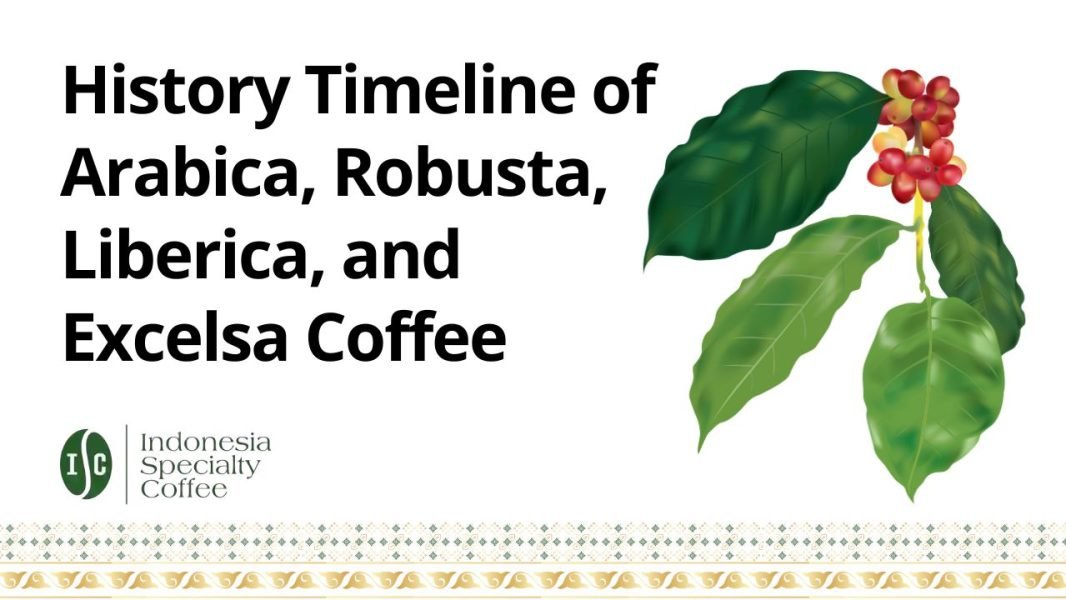Coffee is one of the most consumed beverages in the world, second only to water and tea. While more than 120 Coffea species exist, only four are commercially significant: Arabica, Robusta, Liberica, and Excelsa. Each species has a distinct origin, timeline of global spread, preferred growing altitude, and role in today’s coffee industry. Understanding their history provides context for how coffee shaped trade, culture, and agriculture worldwide.
Global Timeline of Coffee Species: Origins, Altitude, and Market Share
| Year / Century | Region / Origin | Species | Altitude Range (masl) | Today’s Market Share |
|---|---|---|---|---|
| 9th Century | Ethiopia | Arabica | 1,000–2,000 | 60–70% |
| 15th Century | Yemen | Arabica | 1,000–2,000 | 60–70% |
| 16th Century | Middle East & Ottoman Empire | Arabica | 1,000–2,000 | 60–70% |
| 17th Century | Europe | Arabica | 1,000–2,000 | 60–70% |
| 18th Century | Asia (Java), Caribbean, Brazil | Arabica | 1,000–2,000 | 60–70% |
| Mid-19th C. | Liberia (West Africa) | Liberica | 200–600 | <2% |
| Late 19th C. | Southeast Asia | Liberica | 200–600 | <2% |
| 1860s | Congo Basin (Central Africa) | Robusta | 0–800 | 30–40% |
| Early 20th C. | Southeast Asia (Vietnam, Indonesia, Philippines) | Robusta | 0–800 | 30–40% |
| 1904 | Lake Chad (Central Africa) | Excelsa | 200–750 | <1% |
| Early 20th C. | Southeast Asia (Vietnam, Philippines) | Excelsa | 200–750 | <1% |
Sources: Data compiled from the International Coffee Organization (ICO), World Coffee Research (WCR), Specialty Coffee Association (SCA), Uncommon Grounds by Mark Pendergrast, and FAO agricultural records.
Arabica (Coffea arabica)
Arabica is the oldest cultivated coffee species. Its origin traces to the highlands of Ethiopia around the 9th century. By the 15th century, cultivation moved to Yemen, where Sufi communities consumed it to sustain long prayers. From Yemen, Arabica spread across the Arabian Peninsula, Persia, Egypt, and the Ottoman Empire in the 16th century.
In the 17th century, coffee reached Europe through trade in Venice and later spread to London, Paris, and Amsterdam, where coffeehouses became cultural hubs. European colonial powers then introduced Arabica to Java (Indonesia), the Caribbean, and Brazil in the 18th century, establishing global plantations.
Arabica grows best at 1,000–2,000 meters above sea level (masl) in cool tropical climates. Today, it accounts for 60–70% of world coffee production, valued for its sweetness, higher acidity, and complex flavor profile.
Robusta (Coffea canephora)
Robusta was discovered in the Congo Basin in the 1860s. By the late 19th century, it was cultivated across West and Central Africa as a hardy alternative to Arabica. Its spread accelerated in the early 20th century when Southeast Asia, notably Vietnam, Indonesia, and the Philippines, adopted Robusta to replace Arabica plantations devastated by coffee leaf rust disease.
Robusta thrives at 0–800 masl, tolerating higher temperatures and lower altitudes where Arabica cannot survive. Its natural disease resistance, high yield, and higher caffeine content made it a reliable crop for mass production. The flavor is typically stronger, more bitter, and less acidic, often used in instant coffee and espresso blends for body and crema.
Today, Robusta represents 30–40% of global coffee production, second only to Arabica in market share.
Liberica (Coffea liberica)
Liberica originated in Liberia, West Africa, and was classified in the mid-19th century. During the late 1800s, it gained importance when coffee leaf rust destroyed large areas of Arabica plantations in Asia. As a replacement, colonial powers introduced Liberica to the Philippines, Malaysia, and Indonesia, where it adapted well to tropical lowlands.
Liberica grows at 200–600 masl, favoring hot and humid conditions unsuitable for Arabica. It is distinct for its large beans, thick skin, and unique flavor profile, often described as woody, smoky, and fruity with jackfruit-like notes.
Today, Liberica contributes less than 2% of global production, remaining a regional specialty in Southeast Asia with limited international presence.
Excelsa (Coffea excelsa / C. liberica var. dewevrei)
Excelsa was identified in 1904 near Lake Chad, Central Africa. In the early 20th century, it spread to Southeast Asia, with notable cultivation in Vietnam and the Philippines. Later taxonomic revisions classified it as a variety of Liberica, but it remains recognized separately in the coffee trade due to its distinct characteristics.
Excelsa grows at 200–750 masl, similar to Liberica, and adapts well to tropical lowland climates. It is known for tart, fruity, and wine-like notes that add complexity when blended with other coffees.
Excelsa represents less than 1% of the global market, but it holds value in specialty circles for enhancing flavor diversity.
Comparative Timeline & Market Share
- Arabica: 9th century Ethiopia → Yemen (15th) → Middle East (16th) → Europe (17th) → global colonies (18th). Now 60–70% of production. Grows at 1,000–2,000 masl.
- Robusta: 19th-century Congo discovery → expanded Africa & Asia (20th). Now 30–40% of production. Grows at 0–800 masl.
- Liberica: Mid-19th-century Liberia → Asia during the rust epidemic (late 1800s). Now <2% of production. Grows at 200–600 masl.
- Excelsa: Discovered in 1904, Chad → spread to Asia. Now <1% of production. Grows at 200–750 masl.
Conclusion
The history of coffee species reflects adaptation and survival. Arabica dominates for flavor and global demand, Robusta provides strength and resilience, while Liberica and Excelsa preserve biodiversity with unique taste profiles. Together, they form the backbone of world coffee cultivation. Their diverse origins, altitudes, and timelines show how coffee spread from Africa to every continent, shaping economies and cultures while continuing to evolve under modern challenges such as climate change and disease.





